Intel D975XBX: Intel brings their Bad-Axe to Market
by Gary Key on January 26, 2006 12:05 AM EST- Posted in
- Motherboards
Basic Features: Intel D975XBX
| Specification | Intel D975XBX |
| CPU Interface | LGA775-based Pentium 4, Pentium 4 XE, Celeron D, and Pentium D processors |
| Chipset | Intel 975X - MCH ICH7R - ICH |
| Pentium D Support | 820D, 830D, 840D, 840EE, 920D, 930D ,940D ,950D , 955EE |
| Front Side Bus | 1333 / 1067 / 800 / 533 MHz |
| Host Burn-In Mode | 0 - 30% (in 1 percent increments) |
| Memory Speeds | Default, DDR-2 333, 400, 533, 667, and 800MHz |
| PCI Bus Speeds | Default, 40.00MHz |
| PCI Express Bus Speeds | Default, 101.32, 102.64, 103.96, 105.28, 106.6, 107.92, 109.24MHz |
| Set Processor Multiplier | 12 to 40, (in 1 step increments) |
| Core Voltage | Default, 1.2750V to 1.6000V (in 0.0125V increments) |
| DRAM Voltage | Default, 1.80V, 1.90V, 2.00V, 2.10V, 2.20V |
| MCH Chipset Voltage | Default, 1.525V, 1.600V, 1.650V, 1.725V |
| FSB Termination Voltage | Default, 1.271V, 1.333V, 1.395V |
| Memory Slots | (4) x DIMM, max. 8GB, DDR2 667/533/400, non-ECC, ECC, un-buffered memory |
| Expansion Slots | (2) x PCI-E x16 (operates in 1x16 and 1x8 or 2x8 mode) (1) x PCI-E x16 (operates in x4 mode) (2) x PCI 2.3 |
| Onboard SATA | Intel ICH7R: (4) x SATA 3Gb/s |
| Onboard IDE | Intel ICH7R: (1) x UltraDMA 100/66/33 |
| SATA/IDE RAID | Intel ICH7R: (4) x SATA 3Gb/s RAID 0, RAID 1, RAID 5, RAID 10, and Intel Matrix Storage technology Silicon Image SiI 3114: (4) x SATA 1.5Gb/s RAID 0, RAID 1, RAID 0+1 (operates on PCI bus) |
| Onboard USB 2.0/IEEE-1394 | (8) USB2.0 ports (2) IEEE 1394a FireWire Ports by TI TSB43AB23 |
| Onboard LAN | Intel 82573L PCI-E x1 Gb LAN |
| Onboard Audio | Sigmatel STAC9221D, 8-channel capable HD Audio Codec featuring Dolby Master Studio technology |
| Power Connectors | 24-pin ATX 4-pin 12V Plug 8-pin EATX 12V |
| Back Panel I/O Ports | 1 x PS/2 Keyboard 1 x PS/2 Mouse 1 x Parallel 1 x Serial 1 x Audio I/O Panel 1 x Optical S/PDIF Out Port 1 x Coaxial S/PDIF Out Port 1 x RJ45 4 x USB |
| Other Features | Value Added Software: Intel® Audio Studio Intel® Desktop Utilities Intel® Desktop Control Center InterVideo* WinDVD* Ulead* VideoStudio* 9 SE DVD InterVideo* MediaOne* Gold Musicmatch* Jukebox Farstone RestoreIT!* Gold Farstone Gamedrive* Norton* Internet Security Norton* AntiVirus Yahoo!* Toolbar with Anti-spy |
| BIOS | Intel 0420 (01/05/2006) |
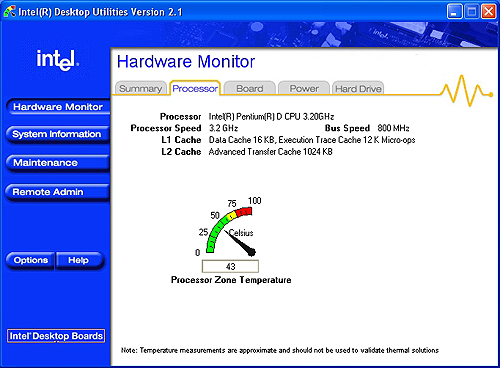
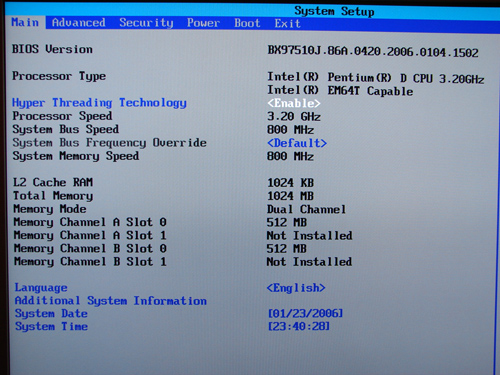
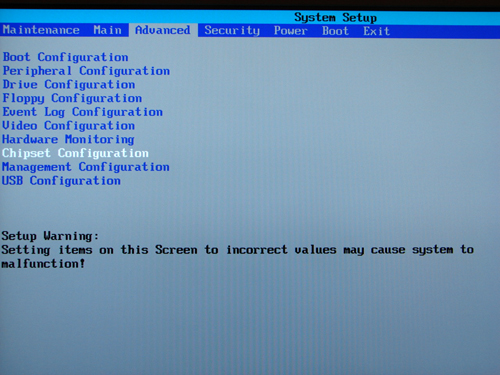
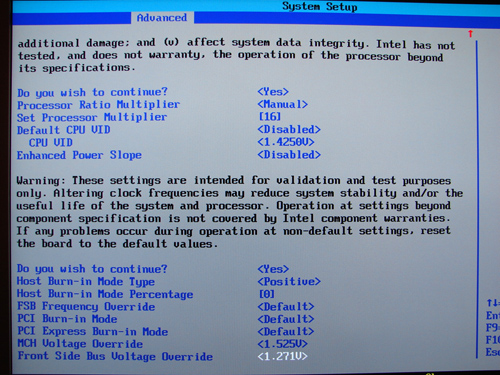
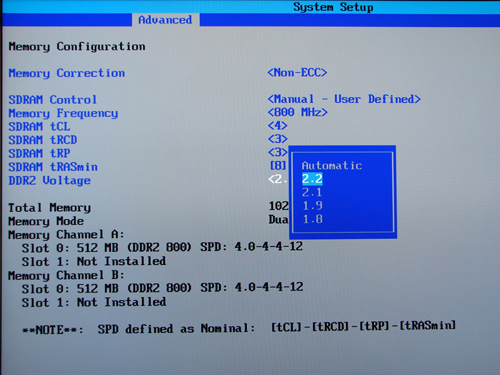
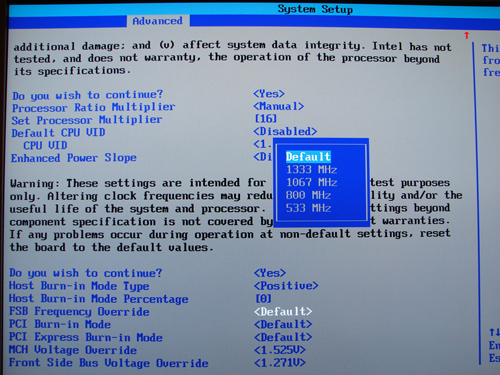










34 Comments
View All Comments
BigP - Wednesday, June 21, 2006 - link
Im a self build Virgin - but I'm going in at the deep end. Intel's site makes their Dual Core stuff sound awsome!(a) Is it?(b)Should I look to spend my cash elsewhere when considering a motherboard/processor?Gary Key - Saturday, July 15, 2006 - link
This board is fine for stock performance and if you get rev-0304 it works very well with Core 2 Duo.FOXY25 - Sunday, February 4, 2007 - link
hi that are my system setting. My system sometimes make complete restart and i dont know why. I have change entire board with another and nothing. Do y think that could be in memory i have 2x DDR2 1024 MB at 800 Mhz Kingmax. thanks for answer.Foxy====== Board ======
Manufacturer Intel Corporation
Product Name D975XBX
Version AAD27094-306
Serial Number BQBX645001ND
BIOS Version BX97510J.86A.1476.2007.0119.1334
BIOS ROM Size 512 KB
BIOS Release Date 19.1.2007
====== Processor ======
Manufacturer Intel(R) Corporation
Processor Name Intel(R) Core(TM)2 CPU 6400 @ 2,13GHz (2 Cores)
Bus Speed 1067 MHz
Processor Speed 2,133 GHz
Stepping 6
Form Factor Other
Hyper-Threading Technology Status Not Supported
====== Cache ======
L1 Cache Data Cache 32 KB, Code Cache 32 KB Per Processor Core
L2 Cache 2048 KB Unified Cache (2048 KB Cache Per 2 Cores)
====== Memory ======
Error Correction Single-bit ECC
Maximum System Memory 4 GB
Memory Slots 4
---- CHAN A DIMM 0 ----
Socket Designation CHAN A DIMM 0
Current Memory Type DDR2
Installed Size No Module Installed
---- CHAN A DIMM 1 ----
Socket Designation CHAN A DIMM 1
Current Memory Type DDR2
Installed Size 1024 MB
Memory Speed 800 MHz
---- CHAN B DIMM 0 ----
Socket Designation CHAN B DIMM 0
Current Memory Type DDR2
Installed Size No Module Installed
---- CHAN B DIMM 1 ----
Socket Designation CHAN B DIMM 1
Current Memory Type DDR2
Installed Size 1024 MB
Memory Speed 800 MHz
====== Onboard Devices ======
#Device Type Ethernet
Device Description Intel (R) 82562 Ethernet Device
Device Status Enabled
#Device Type Sound
Device Description Intel(R) Azalia Audio Device
Device Status Disabled
#Device Type Other
Device Description Silicon Image 3114 SATA RAID Controller
Device Status Disabled
#Device Type Other
Device Description Texas Instruments TSB82AA2 1394A/B Controller
Device Status Disabled
====== Hard Drive ======
#Model ST3320620AS
Max. Transfer Mode UDMA 6 (ATA/133)
Active Transfer Mode UDMA 5 (ATA/100)
S.M.A.R.T. Status Enabled
Size 298,09 GB
#Model ST380811AS
Max. Transfer Mode UDMA 6 (ATA/133)
Active Transfer Mode UDMA 5 (ATA/100)
S.M.A.R.T. Status Enabled
Size 74,53 GB
JarrettV - Thursday, February 23, 2006 - link
Does this board support dolby digital live in the sigmatel audio chipset? I'm looking to replace my old SoundStorm setup.Also, does Intel High Definition = Dolby Digital Live support?
neilfeier - Wednesday, February 22, 2006 - link
Unlike most users of this motherboard that want to use the dual x8 PCIe slots for graphics, I want to use them for benchmarking a pair of x4 data acquisition boards we are developing. I want to test max rates to and from memory, as well as peer-to-peer transfers between the two boards (assuming the MCH allows this).So my question is: Do you think I can I put a x16 or x8 PCIe graphics card in the third x4 PCIe slot hanging off the south bridge? I don't care about graphics performance too much, I just want a dual monitor card that will work in that slot and leave the main two slots free.
And ideas on this would be helpful. Thanks!
Gary Key - Wednesday, February 22, 2006 - link
I will try it this weekend and report back.neilfeier - Friday, March 3, 2006 - link
Thanks Gary, I anxiously await the results of your experiment.Neil
Gary Key - Thursday, March 9, 2006 - link
Hi Neil,I had video working in this slot. I updated to the new bios release today and will test the performance in a couple of days.
Thanks,
Gary
Gary Key - Tuesday, March 28, 2006 - link
Neil,Performance is average but it works.
Gary
Missing Ghost - Monday, January 30, 2006 - link
error! That's not how pcie works! pcie is always full duplex, and never single-ended!